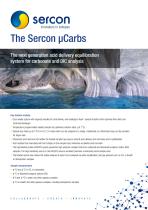
Inorganic elemental analyzer µCarbslaboratoryfor environmental analysiscontinuous
Add to favorites
Compare this product
Characteristics
- Tested parameter
- inorganic elemental
- Applications
- laboratory, for environmental analysis
- Operating mode
- continuous
- Configuration
- benchtop
Description
The measurement of stable isotopes in the carbonate shells of organisms which lived and died in our oceans and fell to ocean floor is possible through the analysis of sediment cores and sedimentary rocks. The δ18O signature of water in the oceans is dependent upon the temperature of the Earth and this signature is taken up into the shells of organisms, therefore we have a proxy for past ocean temperatures. The measurement of DIC in modern samples allows for an analysis of the sources and sinks of atmospheric trace gases, vital information in the drafting of international protocols within which countries around the world seek to work in an attempt to mitigate the effects of climate change. The necessity for accurate and precise measurements of these isotopic signatures is therefore paramount. Both carbonate and DIC analysis require the delivery of phosphoric acid to samples, in order that CO2 be released into the headspace of the sample vial (after it is flushed with helium) and then transferred to the IRMS for isotopic analysis. The Sercon µCarbs is optimised for isotopic analysis of carbonates and DIC. Two needles are used, one for acid delivery, the other for sampling, in order that the sampling needle is not blocked or corroded by the acid. The acid reservoir is kept at an elevated temperature inside the heated sample tray, in order that the acid viscosity is kept low. The acid delivery line is kept as short as possible, in order that the acid does not have time to cool between the reservoir and the sample vial. The µCarbs can be run in both continuous flow and dual inlet mode, for use with the Sercon HS2022 and GEO-HS2022 IRMS instruments.
Catalogs
The Sercon µCarbs
2 Pages
*Prices are pre-tax. They exclude delivery charges and customs duties and do not include additional charges for installation or activation options. Prices are indicative only and may vary by country, with changes to the cost of raw materials and exchange rates.


